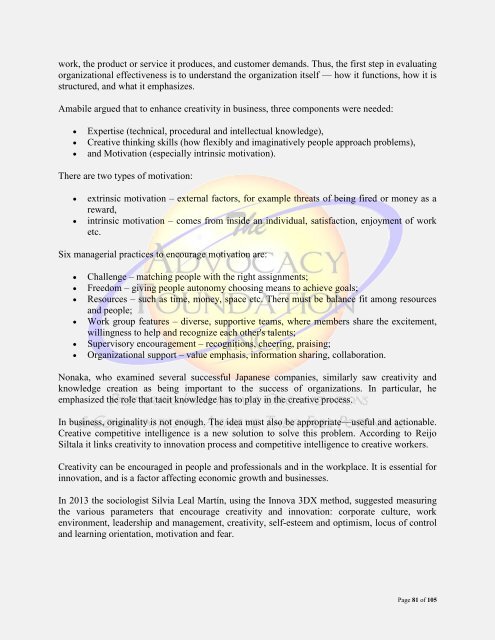Interpreting The Facts
Interpreting The Facts
Interpreting The Facts
Create successful ePaper yourself
Turn your PDF publications into a flip-book with our unique Google optimized e-Paper software.
work, the product or service it produces, and customer demands. Thus, the first step in evaluating<br />
organizational effectiveness is to understand the organization itself — how it functions, how it is<br />
structured, and what it emphasizes.<br />
Amabile argued that to enhance creativity in business, three components were needed:<br />
<br />
<br />
<br />
Expertise (technical, procedural and intellectual knowledge),<br />
Creative thinking skills (how flexibly and imaginatively people approach problems),<br />
and Motivation (especially intrinsic motivation).<br />
<strong>The</strong>re are two types of motivation:<br />
<br />
<br />
extrinsic motivation – external factors, for example threats of being fired or money as a<br />
reward,<br />
intrinsic motivation – comes from inside an individual, satisfaction, enjoyment of work<br />
etc.<br />
Six managerial practices to encourage motivation are:<br />
<br />
<br />
<br />
<br />
<br />
<br />
Challenge – matching people with the right assignments;<br />
Freedom – giving people autonomy choosing means to achieve goals;<br />
Resources – such as time, money, space etc. <strong>The</strong>re must be balance fit among resources<br />
and people;<br />
Work group features – diverse, supportive teams, where members share the excitement,<br />
willingness to help and recognize each other's talents;<br />
Supervisory encouragement – recognitions, cheering, praising;<br />
Organizational support – value emphasis, information sharing, collaboration.<br />
Nonaka, who examined several successful Japanese companies, similarly saw creativity and<br />
knowledge creation as being important to the success of organizations. In particular, he<br />
emphasized the role that tacit knowledge has to play in the creative process.<br />
In business, originality is not enough. <strong>The</strong> idea must also be appropriate—useful and actionable.<br />
Creative competitive intelligence is a new solution to solve this problem. According to Reijo<br />
Siltala it links creativity to innovation process and competitive intelligence to creative workers.<br />
Creativity can be encouraged in people and professionals and in the workplace. It is essential for<br />
innovation, and is a factor affecting economic growth and businesses.<br />
In 2013 the sociologist Silvia Leal Martín, using the Innova 3DX method, suggested measuring<br />
the various parameters that encourage creativity and innovation: corporate culture, work<br />
environment, leadership and management, creativity, self-esteem and optimism, locus of control<br />
and learning orientation, motivation and fear.<br />
Page 81 of 105

















